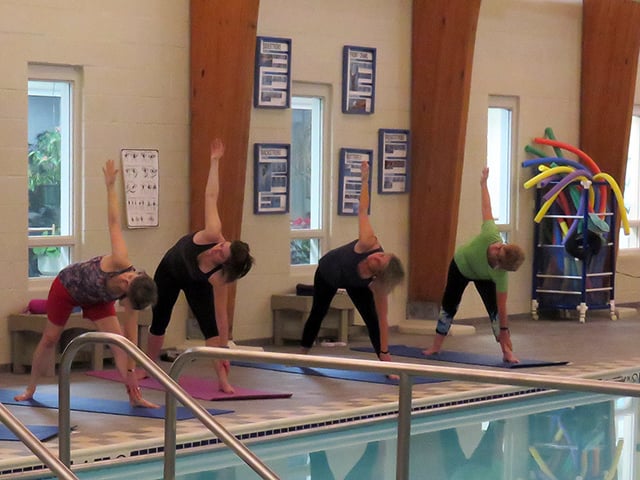Published: August 25, 2023

OK, you get your 10,000 steps in most days, and regularly exercise - swim, bike, aerobic classes and the like - but if you’re like most people, there’s probably one physical activity that needs improvement.
“Most people don’t stretch enough,” says Jill Tvaroha, Kendal’s Wellness Coordinator at Kendal who recently gave a presentation on stretching properly.
We all know it’s important to stretch before and after exercising, but make it last 5 to 10 minutes or longer, Jill says. And you might need a timer or stopwatch to reach your goal.
Also try to stretch before and after sleeping, both while sitting on the side of the bed or lying down.
“Stretching first thing in the morning can relieve any tension or pain from sleeping the night before. It also helps increase your blood flow and prepares your body for the day ahead. And it’s a nice way to wake up. Stretching before bed relaxes your muscles and helps prevent you from waking up with more pain,” Jill says.
Benefits of Stretching
According to the Mayo Clinic, stretching can help improve flexibility, and, as a result, the range of motion of your joints.
“Better flexibility may:
Improve your performance in physical activities;
- Decrease your risk of injuries;
- Help your joints move through their full range of motion;
- Increase muscle blood flow;
- Enable your muscles to work most effectively;
- Improve your ability to do daily activities.”
But it’s important that you stretch properly. Jill says 4 common mistakes are:
- “Instead lean into the stretch gradually, push to the point of mild tension and hold. Each time going a little further, but never forcing it,” Jill says.
- Not holding a stretch long enough. “Hold your stretch position for at least 30 seconds, and up to 60 seconds for even better results,” she says.
- Forgetting form and function. “Pay attention to the muscles you will need to use in your program and make sure your form for each stretch is attained properly,” she says. For instance, if you’re going swimming do stretches for arms and shoulders, for running stretch hamstrings and quads.
- When it comes to an injury, stretching when you should be resting. “If you rub a sore muscle and it feels good, continue, but if you rub a sore muscle and it’s painful, get it checked out. Stretching can make it worse,” Jill says.
Types of Stretching
It’s important you know the difference between dynamic stretching and static or passive stretching.
“The main difference between dynamic stretching and static stretching is that static stretches are performed without movement. In other words, the individual gets into the stretch position and holds the stretch for a specific amount of time. While dynamic stretches are performed with movement. For warming up, dynamic stretching is the most effective, while for cooling down, static and passive are best,” according to The Stretching Institute, a source Jill recommends because of its extensive free library of articles and videos. (You can even search for stretching exercises by a specific sport, from archery to wrestling.)
Dynamic stretches include side to side lunges, squats, wringing out the towel and child’s pose with reaching.
Three common passive stretches are described here by Cleveland Clinic.
Tightness is Not Just Physical
At the Kendal forum there was lots of conversation about “issues in the tissues” from both physical and emotional trauma.
“Headache is a big one,” Jill says. “Think of how you naturally respond. You put your hand to your head and rub your forehead.”
Think of where you “carry” your stress and tension. Neck and shoulders? Stomach? Head? And that can change, depending on activity and challenges. “Be mindful. Do a body scan. Nothing should be tight,” Jill says.
And don’t forget facial stretching, such as yawning, smiling and sighing that can help release emotional tension.
While you don’t need props to properly stretch, blocks, straps and bands come in handy, as does a wall and chair.
Free Guide: 10 Best Practices for Staying Healthy After 60
In our free guide, we share many actions you can take to live a long, healthy and happy life in body, mind and spirit!
 In the past, Molly Kavanaugh frequently wrote about Kendal at Oberlin for the Cleveland Plain Dealer, where she was a reporter for 16 years. Now we are happy to have her writing for the Kendal at Oberlin Community.
In the past, Molly Kavanaugh frequently wrote about Kendal at Oberlin for the Cleveland Plain Dealer, where she was a reporter for 16 years. Now we are happy to have her writing for the Kendal at Oberlin Community.
About Kendal at Oberlin: Kendal is a nonprofit life plan community serving older adults in northeast Ohio. Located about one mile from Oberlin College and Conservatory, and about a 40 minute drive from downtown Cleveland, Kendal offers a vibrant resident-led lifestyle with access to music, art and lifelong learning.




